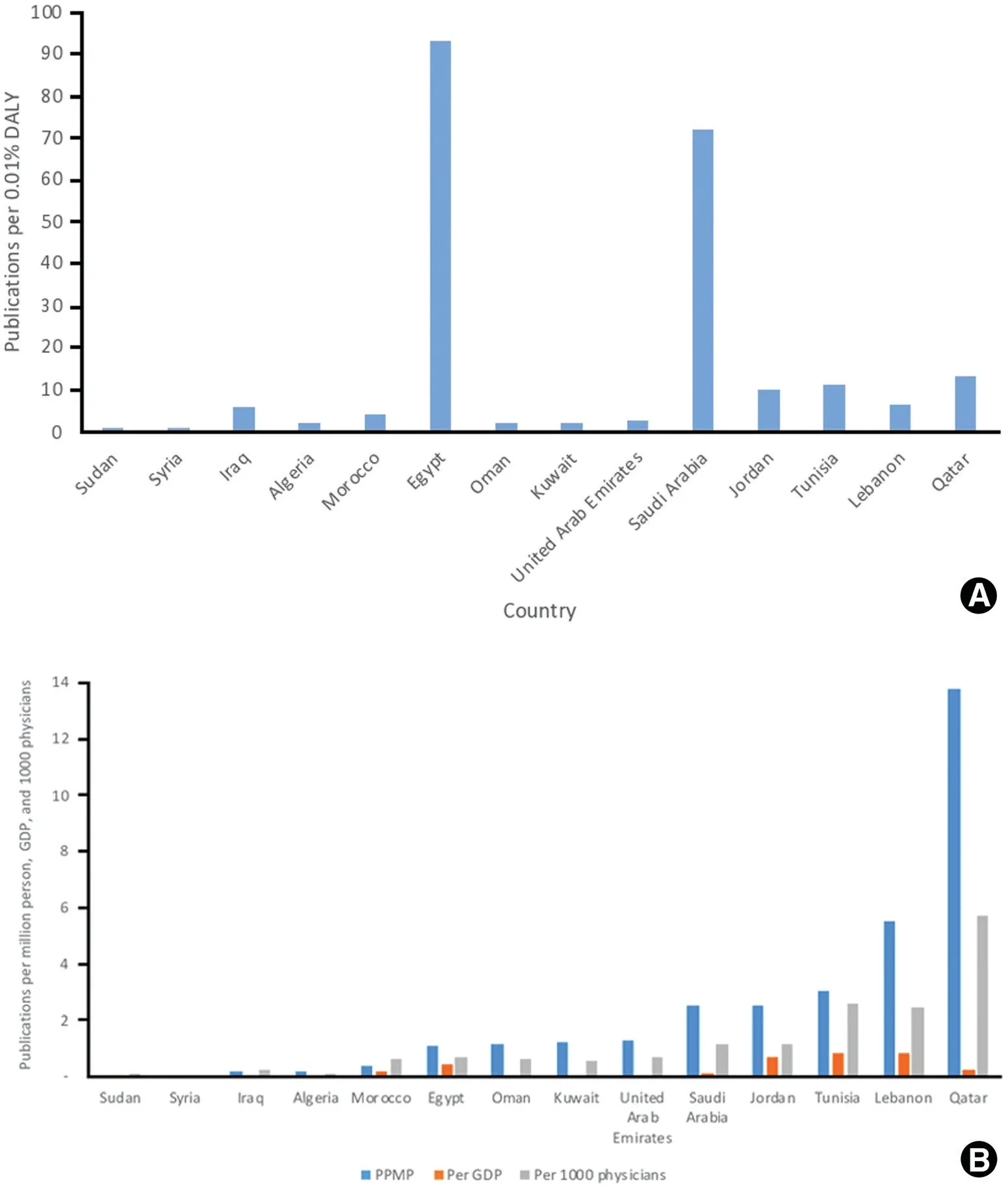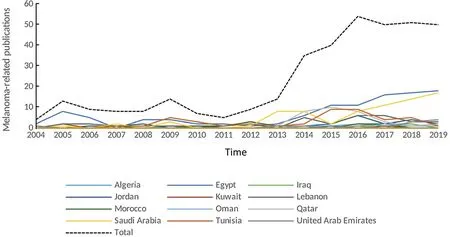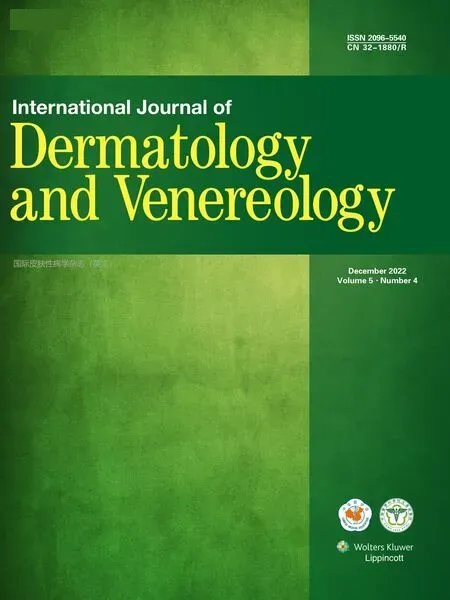Perspective on Melanoma in the Arab World:A Quantitative and Qualitative PubMed-Based Analysis of Research Output (2004–2019)
Lea R. Daou, Said El Hage,2, Yara T. Bteich, Jad E. Hosri,*, Jad A. M. Wehbi
1 Faculty of Medical Sciences, Lebanese University, Roumieh, Beirut 1500, Lebanon; 2 Neuroscience Research Center, Faculty of Medical Sciences, Lebanese University, Roumieh, Beirut 1500, Lebanon.
Melanoma is the most fatal skin cancer, and its incidence has rapidly increased worldwide during the last 50 years,1with a reported 3% increase in its yearly incidence in adolescents and young adults from 1973 to 2001.2The most prominent risk factors for melanoma are ultraviolet radiation, which causes both cell death and malignant transformation, and fair skin.
The Arab world comprises 22 low-latitude countries located in Africa and Asia. Of these 22 countries, 11 are among the 55 countries with the highest percentage of the population aged <15 years. The Arab world’s contribution to the available literature on melanoma remains unclear. In addition, several factors hinder early detection of melanoma, including culture, general education, and the habits of doctors and patients,3such as sun exposure, sunburns during childhood, and the use of indoor tanning.4Thus, population-based research is crucial for implementing screening strategies.
Data regarding tissue and serum markers as well as gene targets and proteins are continuously emerging to guide treatment and prognosis in patients with melanoma.5For instance, use of the serum markers lactate dehydrogenase and S100B for prognosis and monitoring is well established. Other biomarkers are still being investigated in the laboratory setting (eg, melanoma antigen gene A3, microphthalmia-associated transcription factor, and GP100) and are yet to be implemented in clinical practice because many of them are not deemed sensitive or specific.With respect to treatment, BRAF and MEK inhibitors as well as immunotherapy with programmed cell death protein-1 and programmed cell death ligand-1 inhibitors have shown promising results. Another breakthrough concept is the possibility of using circulating tumor DNA to monitor the disease without aggressive procedures.
Hence, we conducted a bibliometric analysis to quantify the research activity in the field of malignant melanoma among Arab countries with adjustment for the gross domestic product (GDP), average population, melanoma-related disability-adjusted life years (DALYs), and the number of physicians (data were obtained from the World Bank Data at https://data.worldbank.org/indicator). We searched the PubMed database using the MeSH term “melanoma,” the Boolean operator “AND”, and each Arab country’s affiliation. Studies were screened for quality and impact using three different indicators: journal quartiles, the H-index (https://www.scimagojr.com/journalrank.php), and the journal’s impact factor from the Journal Citation Reports (https://jcr.clarivate.com). Articles were also screened for the number of citations according to Clarivate Analytics, and the 10 most frequently cited articles were selected. Finally, the co-occurrence of authors and indexed keywords in melanoma-related publications was visualized using the VOSviewer program.Collaborations between organizations were assessed by the same program to evaluate interregional research partnerships. A workflow diagram is shown in Supplemental Figure 1,http://links.lww.com/JD9/A32.
Socioeconomic factors
Melanoma-related DALYs in the Arab world varied from 0.01% to 0.05%. The country with the highest DALYs was Lebanon (0.05%), whereas Sudan, Egypt,Saudi Arabia, Syria, and Iraq had the lowest DALYs. The average population, GDP, and number of physicians are shown in Table 1. Saudi Arabia had the highest average GDP, followed by the United Arab Emirates and Egypt.Egypt had the highest average population, followed by Algeria and Morocco. Egypt also had the highest number of physicians, followed by Saudi Arabia and Algeria. In contrast, Comoros, Djibouti, and Somalia had the lowest numbers of physicians (150,000, 180,000, and 360,000 physicians, respectively).
Number of publications and standardization by socioeconomic factors
The total number of melanoma-related publications by country was 322 articles, accounting for 0.15% of the totalArab research output and 0.67% of the total melanoma literature from 2004 to 2019 (Table 1). Bahrain, Comoros,Djibouti, Libya, Mauritania, Palestine, Yemen, and Somalia had no melanoma-related publications. In contrast, Egypt had the highest number of melanoma-related publications,followed by Saudi Arabia. Among all Arab countries’ total publications, Qatar and Lebanon contributed the most to melanoma, with 0.29% and 0.26% of their total publications dedicated to melanoma, respectively (Table 1). When examining melanoma-related DALYs, Egypt also ranked first with 93 publications per 0.01% melanoma-related DALYs, followed by Saudi Arabia with 72 publications per 0.01% melanoma-related DALYs and Tunisia with 11 publications per 0.01% DALYs (Fig. 1). Additionally,when melanoma-related publications were standardized to the average population, Qatar had the highest number of publications at 13.76 publications per million persons,followed by Lebanon and Tunisia with 5.51 and 3.05 publications per million persons, respectively. Moreover, when standardized to GDP, both Lebanon and Tunisia had the highest number of published articles at 0.8 publications per average GDP. When accounting for the total number of physicians per country, Qatar ranked first at 5.71 publications per thousand physicians, followed by Tunisia and Lebanon with 2.55 and 2.47 publications per thousand physicians, respectively (Fig. 1). Additionally, each country’s total number of publications was significantly correlated with the average GDP, average population, and average number of physicians (P< 0.001). Pearson coefficients were the highest for the average number of physicians (r = 0.843), followed by the average GDP (r = 0.743)and average population (r = 0.644). In contrast, the number of publications was not significantly associated with melanoma-related DALYs (r = -0.241,P= 0.281). Finally,Figure 2 shows that the overall number of melanoma-related publications increased from 2004 to 2019, reaching a peak of 54 articles in 2016 and thereafter stabilizing in the vicinity of 50 articles per year for the subsequent years.

Table 1 Average population, average GDP, mean number of physicians, and numbers of publications in Arab countries.
Publication quartiles, H-index, impact factor,and research areas
In total, 41.2% of the melanoma-related articles in the Arab world were in the first quartile and 36.5% in the second, cumulatively accounting for 78% in the top quartiles. Only 3.4% were in the fourth quartile and 18.6%were in the third. The mean H-index was 106.96 for all articles, meaning that on average, 100 articles were cited at least 100 times. The mean impact factor was 3.09 for all publications, meaning that each melanoma-related publication in the Arab world was published in a journal that was cited three times for each article.
Co-occurrence analysis
Overlay visualization revealed that earlier melanoma research in the Arab world focused on immunohistochemistry (average year: 2013) and differential diagnosis (average year: 2014). Recent research focused more on apoptosis, tumor cell lines, antineoplastic agents, and prognosis (average year: 2015) as well as animals, mice,dermoscopy, immunotherapy, proto-oncogene B-Raf, and mutations (average year: 2016) (Supplemental Figure 2 http://links.lww.com/JD9/A32).

Figure 1. Melanoma-related publications in Arab countries standardized according to disability-adjusted life years (DALYs) (A), publications per million persons (PPMP), gross domestic product (GDP), and 1000 physicians (B). Bahrain, Comoros, Djibouti, Libya, Mauritania,Palestine, Yemen, and Somalia are not shown in the figure because these countries had no have melanoma-related publications.
Analysis of collaborations between universities and organizations in the Arab world using a threshold of three co-authored publications revealed no significant interregional or intraregional joint publications. Notably,Sidra Medical and Research Center in Doha (Qatar) had 10 melanoma-related publications; this center was the most productive organization in the Arab world in terms of melanoma research, followed by Tanta University in Egypt (four publications) and Ain Shams University(three publications).
The most frequently cited article on melanoma in the Arab world was titled “Ultraviolet radiation and skin cancer: molecular mechanisms,” published in 2005 and having 157 citations overall. However, when normalizing the citations to the year of publication, the publication titled“Assessing tumor-infiltrating lymphocytes in solid tumors:a practical review for pathologists and proposal for a standardized method from the International Immuno-Oncology Biomarkers Working Group: Part 2: TILs in melanoma […] and primary brain tumors” ranked first with more than 42.67 citations per year. It was published in 2017 in the journalAdvances in Anatomic Pathology.
Discussion
During the last 16 years, melanoma articles originating from Arab countries accounted for <1% (0.67%) of the total articles. A study by Tadmouri and Bissar-Tadmouri6showed that the conflict between the Arabs and Israelis as well as the wars that occurred in Lebanon, Kuwait, and Iraq played a major role in halting advances in science and medicine.
Despite having the highest number of melanoma publications, Egypt had the highest number of articles only when standardized to DALYs, not when standardized to other parameters. Closer examination revealed that Egypt garnered one of the lowest melanoma-related DALYs (0.01%). These findings indicate a relatively high melanoma-related output from a region with a low disease burden.

Figure 2. Total melanoma-related publications in the Arab world from 2004 to 2019. Each colored line plots the number of melanomarelated publications per Arab country. The dashed line represents the total number of publications in the Arab world. Countries with one or no publications are not shown in this graph for better visibility.
In contrast, countries topping the list of publications per GDP, such as Tunisia and Lebanon, fell short when addressing the number of publications per DALY percentage of wealthier countries, including Egypt and Saudi Arabia. This reflects the need for a directed fund distribution within Arab countries because our data suggest a haphazard allocation of resources when it comes to melanoma research. This point is also highlighted by the lack of a significant association between the number of publications per country and the DALY percentage.
When standardized to the average population and number of physicians, Qatar had the highest number of melanoma-related publications. This could be attributed to the oil discovery in the Arabian Gulf, which fueled the industrialization and modernization of Middle-Eastern countries and changed the pattern in which diseases occur(especially increasing the incidence of cancer) but at the same time providing scientists with facilities and infrastructure necessary for research.7
Lebanon, one of the two countries that had the highest number of publications when normalized to GDP, was also found to have the highest melanoma DALYs. Risk factors contributing to the development of melanoma in Lebanon include lighter skin tone compared with other Arab countries and ultraviolet exposure,1which can be attributed to Lebanon’s major coastline and its Mediterranean climate.
One of the most significant contributions to researchers’ understanding of the biological basis of melanoma was the discovery of driver mutations, most notably the 2002 breakthrough finding of the B-Raf proto-oncogene, serine/threonine kinase mutations. This eventually led in 2011 to the design of immunotherapeutics specifically targeting these mutations, such as vemurafenib.8Additionally, it is notable that up to 4% of patients with melanoma have an unknown primary site and frequent lymph node involvement. This subset of melanoma (ie,melanoma of unknown primary) warrants comparison to melanoma of known primary in the era of novel therapy.9
Our study highlights the evolution of the focus of melanoma research toward immunotherapy and BRAF mutations. Nevertheless, the delay in focusing this research on the biochemical and genetic nature of melanoma in the Arab world is notable: what started in the mid-2000s in the United States only became a trend in the Arab countries around the mid-2010s.
In a study of medical research productivity in Arab countries, Ain Shams University in Egypt was grouped among the 10 most productive institutions in the Arab world,10a finding that was echoed in the present study. In that same study, 42% of the publications from Ain Shams University were found to have international collaborations.10However, the contradiction is obvious: most melanoma-related publications were in top-quartile journals as demonstrated in the present study, but collaborations in melanoma research were very sparse.
In conclusion, during the last 16 years, Arab countries have provided high-quality melanoma research, although this research has been unsatisfactory in quantity because of the major political and socioeconomic instability in the Arab world. These findings highlight the potential for Arab countries to provide valuable contributions to international papers if they are given this chance through future collaborations. Recruitment of individuals of Arab ethnicity could also be an example of inclusivity and a chance to study different skin tones and examine populations with different sun exposure habits. Regional collaborations between high-GDP countries and those with high melanoma DALYs in the Arab world could also be an important stride in melanoma research.
- 国际皮肤性病学杂志的其它文章
- Efficacy and Safety of lxekizumab in Chinese Patients With Moderate-to-Severe Plaque Psoriasis: 60-Week Results From a Phase 3 Study
- Characterization of Generalized Pustular Psoriasis in Northwest China: A Single-Center Retrospective Study
- Understanding the Pathogenesis of Generalized Pustular Psoriasis Based on Molecular Genetics and lmmunopathology
- Laboratory Safety of Dupilumab, and lts Effect on lnflammatory Biomarkers, in Chinese Adults With Moderate-to-Severe Atopic Dermatitis: An Analysis of a Randomized, Double-Blind Phase lll Study
- Sexual Behavior and Awareness of Sexually Transmitted Diseases Among Street-Based Female Sex Workers in the Florence Area, Central Italy
- Perceptions of Acne and Its Treatments Among Chinese College Students: A Cross-Sectional Survey

